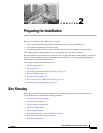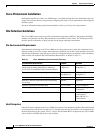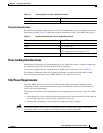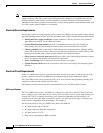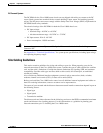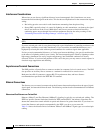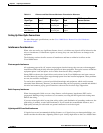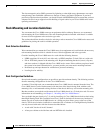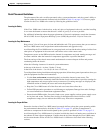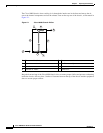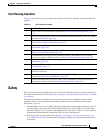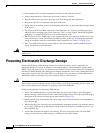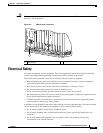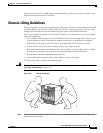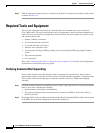
2-9
Cisco 10008 Router Hardware Installation Guide
OL-0659-13
Chapter 2 Preparing for Installation
Site Planning
Rack Placement Guidelines
The placement of the rack can affect personnel safety, system maintenance, and the system’s ability to
operate within the environmental characteristics described in Table 2-1 on page 2-2. Choose a proper
location for the Cisco 10000 series router by following the guidelines below.
Locating for Safety
If the Cisco 10008 router is the heaviest, or the only piece of equipment in the rack, consider installing
it at or near the bottom to ensure that the rack’s center of gravity is as low as possible.
For additional information about the proper placement of electronic equipment, consult the document
GR-63-CORE, Network Equipment Building System (NEBS) Requirements: Physical Protection.
Locating for Easy Maintenance
Keep at least 3 feet of clear space in front and behind the rack. This space ensures that you can remove
the Cisco 10008 router cards and perform routine maintenance and upgrades easily.
Avoid installing the Cisco 10008 router in a congested rack, and consider how the routing of cables from
other pieces of equipment in the same rack could affect access to the routers cards.
Temperature sensors on the PRE monitor the internal air temperature and send warning messages and
an alarm condition when the internal air temperature approaches a specified threshold.
The front and top of the chassis must remain unobstructed to ensure adequate airflow and prevent
overheating inside the chassis.
Allow the following clearances for normal system maintenance:
At the top of the chassis—At least 3 inches (7.6 cm)
In the front of the chassis—3 to 4 ft (91.44 cm to 121.92 cm)
To avoid problems during installation and ongoing operation, follow these general precautions when you
plan the equipment locations and connections:
• Use the show environment command regularly to check the internal system status. The
environmental monitor continually checks the interior chassis environment; it provides warnings for
high temperature and creates reports on any occurrences. If warning messages are displayed, take
immediate action to identify the cause and correct the problem.
• Keep the Cisco 10008 router off of the floor and out of areas that collect dust.
• Follow ESD prevention procedures to avoid damage to equipment. Damage from static discharge
can cause immediate or intermittent equipment failure.
• Ensure that the PRE modules, line cards, blank covers, power supplies, and any power supply covers
are in place and secure. The fans direct cooling air throughout the chassis interior; a loose
component or empty slot can redirect the airflow away from active components.
Locating for Proper Airflow
Ensure the location of the Cisco 10008 router has enough airflow to keep the system operating within
the environmental characteristics described in Table 2-1 on page 2-2, and the air temperature is
sufficient to compensate for the heat dissipated by the system as specified in Table 2-2 on page 2-3.
Avoid locating the Cisco 10008 router in a location in which the chassis air intake vents could draw in
the exhaust air from adjacent equipment. Consider how the air flows through the Cisco 10008 router,
and be aware that the airflow of the Cisco 10008 chassis is different as described in the following
sections.



